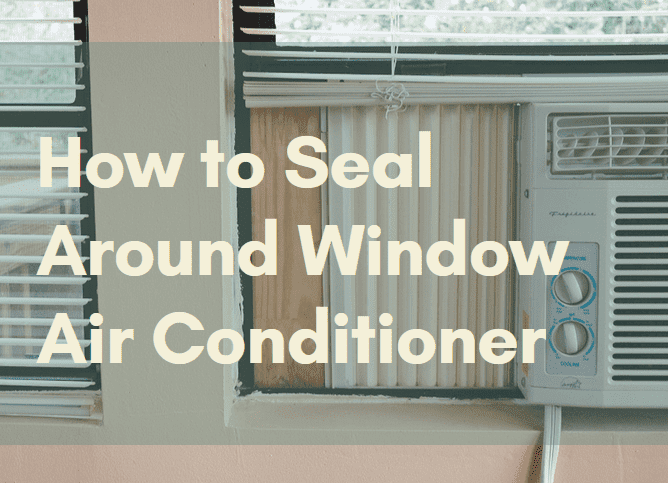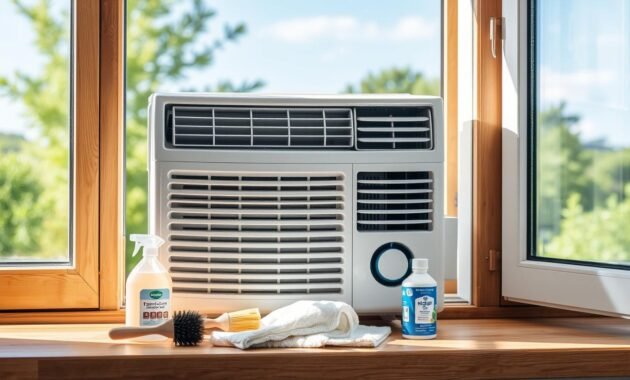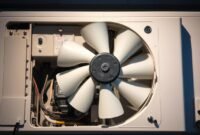Are you fed up with high energy bills and hot indoor temperatures? Window unit air conditioning can waste a lot of energy if not sealed right. Gaps around your AC let cool air out and hot air in, making your system work too hard and costing you money.
Sealing your window AC isn’t just about upkeep—it’s a smart way to make your home more comfortable and save on energy. This guide will teach you easy steps to seal your AC unit. You’ll learn how to keep your space cool and your wallet happy.

Understanding Window AC Units and Their Common Sealing Issues
Window air conditioners keep homes cool but can waste energy if not sealed right. Up to 25% of cooled air can leak through small gaps. This raises cooling costs and lowers home comfort.
Read also: Need AC for Room with no Windows?
For window ac weatherproofing, knowing where air leaks happen is key. Every small gap can cut down cooling efficiency and hike up energy bills.
Types of Air Leaks Around Window Units
Sealing a window mounted ac requires spotting specific leak spots. Common leak areas include:
- Gaps between the AC unit and window frame
- Edges of the window where the unit is installed
- Loose or damaged window AC side panels
- Deteriorated window sealant
Impact of Poor Sealing on Energy Efficiency
Poor insulation in window air conditioners wastes a lot of energy. Unsealed units make your cooling system work harder, leading to:
- Higher electricity use
- Higher energy bills each month
- Less cooling power
- More strain on your AC unit
Common Problem Areas to Address
To boost your window AC’s efficiency, focus on key sealing spots. Paying attention to these areas can save energy and keep your home comfy.
- Check weatherstripping condition
- Inspect window frame integrity
- Examine AC unit’s exterior edges
- Look for visible gaps or cracks
Essential Tools and Materials for Sealing Your Window AC
To seal your window AC, you need the right tools and materials. I’ve dealt with window ac air leaks many times. I’ll show you what you need for a tight, energy-saving seal.
First, gather these key items:
- Utility knife for precise cutting
- Rope caulk for flexible sealing
- Non-abrasive cleaning solution
- Weatherstripping
- Foam insulation panels
- HVAC aluminum tape
- High-quality exterior caulk
The right materials are key to stopping air leaks. Invest in top-notch weatherstripping and foam insulation for your window AC. These items help seal tight, saving energy and boosting your AC’s performance.
Choose materials based on your window and AC type. Different setups need different solutions for a perfect seal. Focus on the edges and sides, where leaks often happen.
Pro tip: Buy a bit more material than you think you’ll need. This way, you can fix mistakes and have enough for the whole job.
Preparing Your Window AC Unit for Sealing
Before sealing your window air conditioner, you need to prepare it well. I’ll show you how to get your AC ready for a tight seal. This seal stops cold air from leaking out and warm air from getting in.
To seal your window air conditioner, you must pay close attention. First, remove the unit from the window carefully. Make sure it’s supported well to avoid damage.
Read also: What To Do If Your Window Air Conditioner Smells Like Chemicals
Cleaning and Inspection Checklist
- Unplug the air conditioner completely
- Remove any visible dirt and debris from the unit’s exterior
- Inspect the unit for any signs of wear or damage
- Clean the air filters thoroughly
- Check electrical connections and cord integrity
Positioning Techniques for Optimal Sealing
Getting the air conditioner in the right spot is important. Place it on a clean, flat surface. This makes it easy to inspect and clean all sides.
| Positioning Consideration | Recommended Action |
|---|---|
| Unit Angle | Slightly tilted outward for proper drainage |
| Surface | Clean, flat, and stable workspace |
| Accessibility | Ensure all sides are easily reachable |
Removing Old Sealant and Debris
Use a plastic scraper to remove old sealant carefully. Be gentle to avoid harming the window or air conditioner. Focus on areas where warm air might leak in, making sure they’re clean for new sealant.
By following these steps, you’ll set up your window air conditioner for a tight seal. This will help keep your energy bills down and your home comfortable. Take your time and do it right for better results.
How to Seal Around Window Air Conditioner

Sealing around a window air conditioner is key for better energy use and comfort at home. I found several good ways to seal these units, which stop air leaks and cut down on energy costs.
First, get the right stuff for easy sealing. You’ll need:
- Rigid foam insulation panels
- Weatherstripping
- Measuring tape
- Utility knife
- Caulk and caulking gun
The side panels of your window AC unit need the most attention. Measure them well and cut the foam to fit just right. Styrofoam is a cheap but good insulator. Cut the panels a bit smaller than the space for a snug fit.
Install the foam panels by pressing them gently into place. Use weatherstripping to block more air leaks. If it’s hard, don’t worry. Most units are easy to install, and you can return it if you have trouble.
Pro tip: Check the seal often and add more weatherstripping or caulk as needed. A well-sealed air conditioner can lower your energy bills and make your home more comfortable.
Using Foam Insulation and Weather Stripping
To make a good sliding window seal for air conditioners, you need to be precise and know the right products. I’ll show you how to use foam insulation and weather stripping. This will help your window AC unit work better and save energy.
Sealing your windows well stops air leaks and saves energy. I’ll explain the important steps to get a tight seal around your air conditioner.
Measuring and Cutting Foam Panels
Getting the right measurements is key for a good seal. Here’s how to do it:
- Measure the gaps around your window AC unit carefully
- Use a sharp utility knife for clean cuts
- Choose high-density foam insulation panels
- Cut panels a bit larger than the gaps
Installing Weather Stripping Correctly
Weather stripping adds extra protection against air leaks. Here’s how to install it right:
- Clean the surface well before you start
- Use self-adhesive weather stripping for easy installation
- Press firmly to make sure it sticks well
- Trim any extra material for a clean look
Securing Side Panels
To make your seal even better, use HVAC tape to attach foam panels. This step makes your seal last longer and keeps air out.
| Sealing Material | Effectiveness | Durability |
|---|---|---|
| Foam Insulation | High | Medium |
| Weather Stripping | Very High | High |
| HVAC Tape | Medium | Very High |
By using these methods, you’ll get a professional-grade seal. This will keep your home cozy and save energy.
Applying Caulk and Sealants Effectively
Choosing the right caulk or sealant is key for keeping your home draft-free and bug-free. I’ll show you how to seal your window air conditioner. This will make your home airtight.
When picking a sealant, consider these three types:
- Latex Sealants: Water-based and easy to apply
- Silicone Sealants: Highly flexible and weather-resistant
- Hybrid Sealants: Combine the best properties of multiple sealant types
To seal your window AC and keep bugs out, follow these steps:
- Clean the area around the air conditioner thoroughly
- Remove any old, cracked sealant
- Choose a high-quality, flexible sealant
- Apply the sealant in a smooth, continuous bead
- Smooth out the sealant with a caulking tool
| Sealant Type | Best Used For | Durability |
|---|---|---|
| Latex | Indoor use, easy application | 1-3 years |
| Silicone | Outdoor and indoor sealing | 5-10 years |
| Hybrid | Versatile applications | 3-5 years |
Pro tip: For the best results, apply sealant when temperatures are moderate and the surface is completely dry. This ensures maximum adhesion and creates a long-lasting seal that keeps your home comfortable and bug-free.
Advanced Sealing Techniques for Double-Hung Windows
Double-hung windows are tricky for window ac installation. They have special features that make sealing hard. I’ll share some advanced methods to get a tight seal and save energy.
Double-hung windows have a unique design. The space between the panes can let air leak out. This hurts your air conditioner’s work and raises your energy bills.
Addressing Gaps Between Window Panes
To seal these gaps well, try these steps:
- Measure the gap between the panes carefully
- Use high-density foam inserts that fit perfectly
- Apply weatherstripping on the inside edges of the window
- Use removable silicone sealants for quick fixes
Window Type-Specific Sealing Strategies
Each window type needs its own ac installation method. Here’s a quick guide for different windows:
| Window Type | Recommended Sealing Method | Difficulty Level |
|---|---|---|
| Traditional Double-Hung | Foam panel + weatherstripping | Easy |
| Sliding Windows | Custom foam wedges | Moderate |
| Casement Windows | Specialized compression seals | Complex |
Using these advanced sealing methods will make your cooling system work better. It will also stop air from getting in where it shouldn’t.
Read also: Hisense Portable Air Conditioner Troubleshooting
Seasonal Maintenance and Care Tips

Keeping your window air conditioner in good shape is key. It helps it work better and last longer. This is even more important when it’s not in use during off-seasons.
For your window AC to stay in top shape, follow these care tips:
- Clean the air filter well before winter storage
- Take the unit out of the window if you can during cold months
- Use a breathable cover to keep dust and moisture out
- Store it in a dry, controlled temperature space
If you can’t remove the AC, use good insulation. Foam panels and weatherstripping can seal air leaks. This keeps cold air out and protects the AC from winter damage.
Regular upkeep is more than just saving money. It makes sure your AC cools well when summer comes. Clean and check it every spring for any damage from storage.
- Look over electrical connections
- Check for rust or corrosion
- Test the unit before the first hot day
- Replace weatherstripping if it’s worn
By following these tips, you’ll get the most out of your window AC. You’ll save money and stay comfortable all year.
Troubleshooting Common Sealing Problems
Sealing a window mounted AC can be challenging. Even the most careful homeowners face air leaks around their window AC units. Finding and fixing these issues quickly keeps your unit running well and saves energy.
I’ve found some effective ways to tackle common window ac air leaks. These tips can save you time and money.
Detecting Hidden Air Leaks
To spot sneaky air leaks around your window air conditioner, try these methods:
- Use a candle or incense stick near window edges
- Check for visible gaps or cracks
- Feel for temperature differences around the unit
- Listen for whistling sounds during operation
Quick Repair Solutions
When you find window ac air leaks, here are some quick fixes:
- Apply weatherstripping to seal small gaps
- Use foam insulation panels for larger openings
- Replace worn-out caulking
- Adjust unit’s positioning in the window frame
When to Replace Sealing Materials
Sealing materials for your window mounted AC need to be replaced if you see:
| Condition | Action Required |
|---|---|
| Cracked or brittle weatherstripping | Immediate replacement |
| Persistent air leaks after resealing | Professional inspection recommended |
| Visible mold or moisture damage | Complete seal replacement |
Regular maintenance stops energy loss and keeps your home cool in summer.
Conclusion
I’ve shown you how to seal around window air conditioners. This helps make your cooling system better. It’s not just about feeling comfortable—it’s also about saving energy.
Using the methods we talked about can make your window AC work much better. An energy-efficient AC with a good seal stops air leaks. This means less energy use and a cooler home. The effort you put in will save you money and keep you comfortable.
Sealing around your window AC might seem hard, but it’s easy once you get the hang of it. With a bit of practice, you’ll feel more confident in keeping your AC in top shape. Remember, keeping your AC well-maintained and sealed can make it last longer and work better.
Keeping cool in the summer doesn’t have to cost a lot. With these tips, you can make your home more energy-efficient and comfortable. Take the time to check, seal, and care for your window AC. Your wallet and your comfort will appreciate it.


